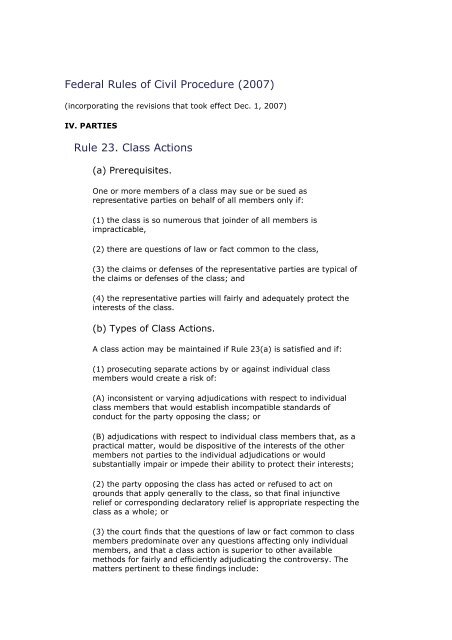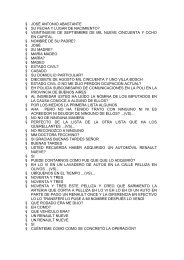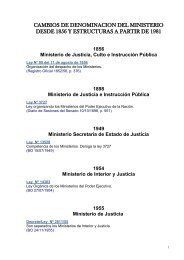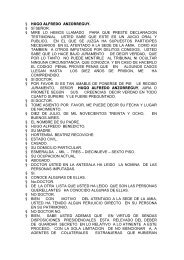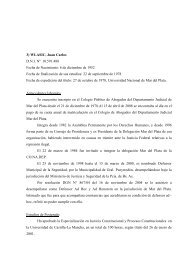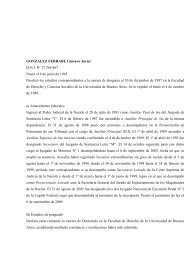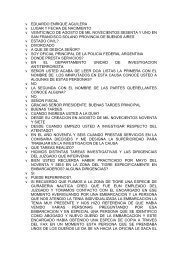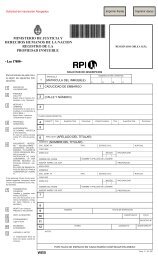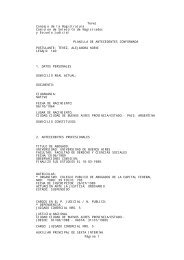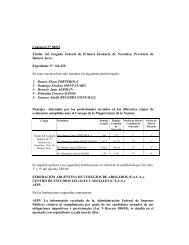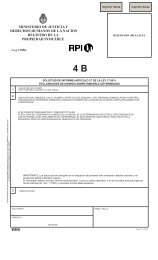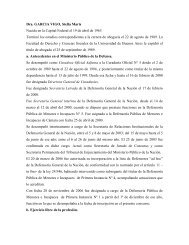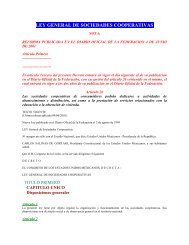Federal Rules of Civil Procedure (2007) Rule 23. Class Actions
Federal Rules of Civil Procedure (2007) Rule 23. Class Actions
Federal Rules of Civil Procedure (2007) Rule 23. Class Actions
- No tags were found...
Create successful ePaper yourself
Turn your PDF publications into a flip-book with our unique Google optimized e-Paper software.
<strong>Federal</strong> <strong><strong>Rule</strong>s</strong> <strong>of</strong> <strong>Civil</strong> <strong>Procedure</strong> (<strong>2007</strong>)(incorporating the revisions that took effect Dec. 1, <strong>2007</strong>)IV. PARTIES<strong>Rule</strong> <strong>23.</strong> <strong>Class</strong> <strong>Actions</strong>(a) Prerequisites.One or more members <strong>of</strong> a class may sue or be sued asrepresentative parties on behalf <strong>of</strong> all members only if:(1) the class is so numerous that joinder <strong>of</strong> all members isimpracticable,(2) there are questions <strong>of</strong> law or fact common to the class,(3) the claims or defenses <strong>of</strong> the representative parties are typical <strong>of</strong>the claims or defenses <strong>of</strong> the class; and(4) the representative parties will fairly and adequately protect theinterests <strong>of</strong> the class.(b) Types <strong>of</strong> <strong>Class</strong> <strong>Actions</strong>.A class action may be maintained if <strong>Rule</strong> 23(a) is satisfied and if:(1) prosecuting separate actions by or against individual classmembers would create a risk <strong>of</strong>:(A) inconsistent or varying adjudications with respect to individualclass members that would establish incompatible standards <strong>of</strong>conduct for the party opposing the class; or(B) adjudications with respect to individual class members that, as apractical matter, would be dispositive <strong>of</strong> the interests <strong>of</strong> the othermembers not parties to the individual adjudications or wouldsubstantially impair or impede their ability to protect their interests;(2) the party opposing the class has acted or refused to act ongrounds that apply generally to the class, so that final injunctiverelief or corresponding declaratory relief is appropriate respecting theclass as a whole; or(3) the court finds that the questions <strong>of</strong> law or fact common to classmembers predominate over any questions affecting only individualmembers, and that a class action is superior to other availablemethods for fairly and efficiently adjudicating the controversy. Thematters pertinent to these findings include:
(A) the class members' interests in individually controlling theprosecution or defense <strong>of</strong> separate actions;(B) the extent and nature <strong>of</strong> any litigation concerning thecontroversy already begun by or against class members;(C) the desirability or undesirability <strong>of</strong> concentrating the litigation <strong>of</strong>the claims in the particular forum; and(D) the likely difficulties in managing a class action.(c) Certification Order; Notice to <strong>Class</strong> Members;Judgment; Issues <strong>Class</strong>es; Subclasses.(1) Certification Order.(A) Time to Issue. At an early practicable time after a person sues oris sued as a class representative, the court must determine by orderwhether to certify the action as a class action.(B) Defining the <strong>Class</strong>; Appointing <strong>Class</strong> Counsel. An order thatcertifies a class action must define the class and the class claims,issues, or defenses, and must appoint class counsel under <strong>Rule</strong>23(g).(C) Altering or Amending the Order. An order that grants or deniesclass certification may be altered or amended before final judgment.(2) Notice.(A) For (b)(1) or (b)(2) <strong>Class</strong>es. For any class certified under <strong>Rule</strong>23(b)(1) or (b)(2), the court may direct appropriate notice to theclass.(B) For (b)(3) <strong>Class</strong>es. For any class certified under <strong>Rule</strong> 23(b)(3),the court must direct to class members the best notice that ispracticable under the circumstances, including individual notice to allmembers who can be identified through reasonable effort. The noticemust clearly and concisely state in plain, easily understood language:(i) the nature <strong>of</strong> the action;(ii) the definition <strong>of</strong> the class certified;(iii) the class claims, issues, or defenses;(iv) that a class member may enter an appearance through anattorney if the member so desires;(v) that the court will exclude from the class any member whorequests exclusion;(vi) the time and manner for requesting exclusion; and
(vii) the binding effect <strong>of</strong> a class judgment on members under <strong>Rule</strong>23(c)(3).(3) Judgment.Whether or not favorable to the class, the judgment in a class actionmust:(A) for any class certified under <strong>Rule</strong> 23(b)(1) or (b)(2), include anddescribe those whom the court finds to be class members; and(B) for any class certified under <strong>Rule</strong> 23(b)(3), include and specify ordescribe those to whom the <strong>Rule</strong> 23(c)(2) notice was directed, whohave not requested exclusion, and whom the court finds to be classmembers.(4) Particular Issues.When appropriate, an action may be brought or maintained as aclass action with respect to particular issues.(5) Subclasses.When appropriate, a class may be divided into subclasses that areeach treated as a class under this rule.(d) Conducting the Action.(1) In General.In conducting an action under this rule, the court may issue ordersthat:(A) determine the course <strong>of</strong> proceedings or prescribe measures toprevent undue repetition or complication in presenting evidence orargument;(B) require — to protect class members and fairly conduct the action— giving appropriate notice to some or all class members <strong>of</strong>:(i) any step in the action;(ii) the proposed extent <strong>of</strong> the judgment; or(iii) the members' opportunity to signify whether they consider therepresentation fair and adequate, to intervene and present claims ordefenses, or to otherwise come into the action;(C) impose conditions on the representative parties or onintervenors;(D) require that the pleadings be amended to eliminate allegationsabout representation <strong>of</strong> absent persons and that the action proceedaccordingly; or
(E) deal with similar procedural matters.(2) Combining and Amending Orders.An order under <strong>Rule</strong> 23(d)(1) may be altered or amended from timeto time and may be combined with an order under <strong>Rule</strong> 16.(e) Settlement, Voluntary Dismissal, or Compromise.The claims, issues, or defenses <strong>of</strong> a certified class may be settled,voluntarily dismissed, or compromised only with the court's approval.The following procedures apply to a proposed settlement, voluntarydismissal, or compromise:(1) The court must direct notice in a reasonable manner to all classmembers who would be bound by the proposal.(2) If the proposal would bind class members, the court may approveit only after a hearing and on finding that it is fair, reasonable, andadequate.(3) The parties seeking approval must file a statement identifyingany agreement made in connection with the proposal.(4) If the class action was previously certified under <strong>Rule</strong> 23(b)(3),the court may refuse to approve a settlement unless it affords a newopportunity to request exclusion to individual class members whohad an earlier opportunity to request exclusion but did not do so.(5) Any class member may object to the proposal if it requires courtapproval under this subdivision (e); the objection may be withdrawnonly with the court's approval.(f) Appeals.A court <strong>of</strong> appeals may permit an appeal from an order granting ordenying class-action certification under this rule if a petition forpermission to appeal is filed with the circuit clerk within 10 days afterthe order is entered. An appeal does not stay proceedings in thedistrict court unless the district judge or the court <strong>of</strong> appeals soorders.(g) <strong>Class</strong> Counsel.(1) Appointing <strong>Class</strong> Counsel.Unless a statute provides otherwise, a court that certifies a classmust appoint class counsel. In appointing class counsel, the court:(A) must consider:(i) the work counsel has done in identifying or investigating potentialclaims in the action;
(ii) counsel's experience in handling class actions, other complexlitigation, and the types <strong>of</strong> claims asserted in the action;(iii) counsel's knowledge <strong>of</strong> the applicable law; and(iv) the resources that counsel will commit to representing the class;(B) may consider any other matter pertinent to counsel's ability t<strong>of</strong>airly and adequately represent the interests <strong>of</strong> the class;(C) may order potential class counsel to provide information on anysubject pertinent to the appointment and to propose terms forattorney's fees and nontaxable costs;(D) may include in the appointing order provisions about the award<strong>of</strong> attorney's fees or nontaxable costs under <strong>Rule</strong> 23(h); and(E) may make further orders in connection with the appointment.(2) Standard for Appointing <strong>Class</strong> Counsel.When one applicant seeks appointment as class counsel, the courtmay appoint that applicant only if the applicant is adequate under<strong>Rule</strong> 23(g)(1) and (4). If more than one adequate applicant seeksappointment, the court must appoint the applicant best able torepresent the interests <strong>of</strong> the class.(3) Interim Counsel.The court may designate interim counsel to act on behalf <strong>of</strong> aputative class before determining whether to certify the action as aclass action.(4) Duty <strong>of</strong> <strong>Class</strong> Counsel.<strong>Class</strong> counsel must fairly and adequately represent the interests <strong>of</strong>the class.(h) Attorney’s Fees and Nontaxable Costs.In a certified class action, the court may award reasonable attorney'sfees and nontaxable costs that are authorized by law or by theparties' agreement. The following procedures apply:(1) A claim for an award must be made by motion under <strong>Rule</strong>54(d)(2), subject to the provisions <strong>of</strong> this subdivision (h), at a timethe court sets. Notice <strong>of</strong> the motion must be served on all partiesand, for motions by class counsel, directed to class members in areasonable manner.(2) A class member, or a party from whom payment is sought, mayobject to the motion.
(3) The court may hold a hearing and must find the facts and stateits legal conclusions under <strong>Rule</strong> 52(a).(4) The court may refer issues related to the amount <strong>of</strong> the award toa special master or a magistrate judge, as provided in <strong>Rule</strong>54(d)(2)(D).


